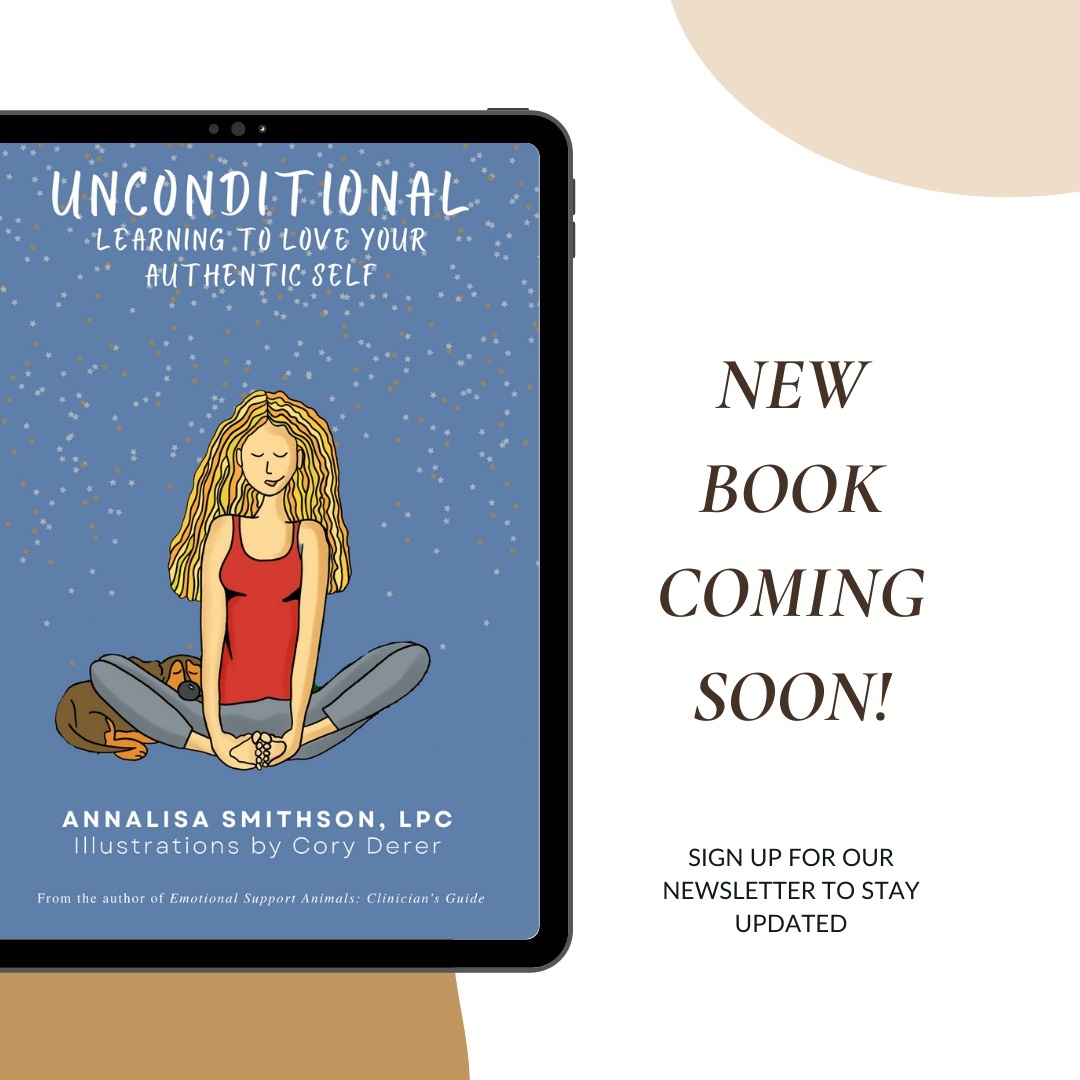Tackle Your Self-Doubt

The following is an excerpt from Unconditional: Learning to Love Your Authentic Self by Annalisa Smithson, LPC (currently in press; please email us if you are interested in being a beta-reader for this publication!)
Have you ever felt the painful twinge of self-doubt? The upset stomach, shallow breaths, and hot, flushed face: all tell-tale signs of a sudden drop in confidence. For some of us, it’s a snide voice with a microphone inside our brains, batting down new ideas before they ever get off the ground. For others, it’s a soft whisper, keeping us “safe” by gently refusing to let us take risks. Whatever your “self-doubt” sounds like, know that it’s a perfectly normal experience.
Self-doubt is especially common when we’re taking on a new challenge in life. Most of us have lost sleep the night before a big presentation, questioned our appearance, odor, and ability to talk before a first date, or wondered about our sanity as we submitted notice to quit one job and start a new one. Even in the therapy room, when my clients are reclining on the comfy chair with a hand tucked under Benji’s “Pet Me” harness—a safe and comfortable environment—people experience the unfriendly bite of self-doubt. “Can my life really look like a miracle? How would I ever create that life? Do I even deserve it?” (Yes. You absolutely deserve it.)
You can address self-doubt with a number of techniques. I’m going to teach you four. The first one is “Challenging Negative Thinking,” which is a cognitive behavioral therapy (CBT) technique. The second is “Small Victories,” a technique that comes from animal-assisted therapy practices. The third is “Apple Core,” a playful way of embracing your strengths inspired by a childhood prank. The last, but certainly not least, is “Supportive Character,” which is drawn from narrative therapy.
Challenging Negative Thinking
Good, old-fashioned, evidence-based CBT techniques can challenge negative thinking and help you eliminate self-doubt. CBT is a well-researched, well-supported model that has helped thousands of people. Albert Ellis and Aaron T. Beck, psychologists active in the 1950s and 60s, respectively, developed the precursors to cognitive behavioral therapy. They believed that developing a negative view of the self would lead to a negative view of the world and one’s future. They saw it as a feedback loop that could grow in either direction. In other words, a negative view of the world could lead to a negative view of self or vice versa. Albert Ellis identified the twelve most common irrational thoughts and suggested specific rational thoughts to use in place of them. CBT therapists have further developed this concept into “cognitive distortions” or “maladaptive thought patterns.” If you can identify your go-to thought patterns, you can also identify ways to combat the negative thoughts. It’s like your brain is an old dog set in its ways. CBT allows you to teach that old dog brain of yours new tricks.
What does this have to do with self-doubt? Well, it’s likely that your self-doubt doesn’t reflect the real picture. You probably express your self-doubt as a cognitive distortion (we all do it sometimes) and it fits into a negative loop that keeps you immersed in your problems. Your thoughts basically run in circles chasing their own tail (and tale) of self-doubt. It might help to have an example: If you’re getting ready for a first date and you notice a blemish on your skin, you might think, “A zit?! I’m hideous. I might as well cancel this date. I’m going to die alone, surrounded by cats, and full of cheese.” This is an example of “catastrophic thinking.” Your rational brain knows that zits do not lead to a lonely death. Also, if you keep telling yourself you’re hideous and will end up alone, chances are you won’t agree to many dates. You may decide the world of romance is hideous, too. Your negative thoughts about yourself and the world get sucked into a painful loop that keeps you lonely and scared.
Here are the most common cognitive distortions:
1. Filtering: Focusing on a single negative detail and ignoring the rest of the situation.
2. Catastrophizing: Looking for the worst possible outcome in any negative situation.
3. Personalization: Assuming all comments and actions are personally directed at you or that you are the direct cause of a situation; attributing yourself as the cause of other people’s actions.
4. Jumping to Conclusions: Assuming that you know what other people are thinking and feeling.
5. Fortune-Telling: Assuming that you know how the situation will turn out.
6. Emotional Reasoning: Assuming that if you feel this way, it must be true, even if the feeling is based in an unhealthy emotion.
7. “Should/Must/Ought” Statements: Making decisions based on a list of rules for how people should behave. When you violate your “should” rules, you feel guilty. When others violate your “should” rules, you feel angry. Albert Ellis called these statements “musterbation.”
8. Polarized Thinking: Using an all-or-nothing mindset; approaching decisions with an either/or attitude.
9. Minimization: The other side of the catastrophizing coin: it refers to discounting or minimizing the positive situations in life.
10. Justification or Moral Licensing: Telling yourself it is okay to violate your standards or values because you’re usually so good. For example, you make progress toward your goal of not stealing, so you reward yourself by lifting a candy bar.
Do any of these common maladaptive thought patterns seem familiar to you? If you catch yourself doing one or two of them on a consistent basis, you may be tempted to chastise yourself. STOP. DROP. ROLL AWAY FROM THE JUDGMENTS. Seriously, don’t judge yourself. There’s a reason psychologists can list ten cognitive distortions and guarantee that most people will see themselves in the list. They are all extremely common. Remember the sociology lesson from Chapter One on Human Socialization? We’re taught to think this way as children, and it is reinforced in hundreds of circumstances as we grow older. The point is not to judge or chastise yourself. Simply notice that you have a particular pattern of thinking. The more you notice it, the less it will happen. That may seem counterintuitive but trust me. If you want to kickstart the healing, you can give yourself a simple, rational mantra to combat the negative thought as it occurs. For example, “Catastrophizing will get me nowhere. What’s the rational truth?” Follow that thought with the rational truth about the situation: “It’s true I have a zit, but I also have facial cleanser, a fancy new outfit, and a dazzling personality. This date will be fun.”
Setting Yourself Up for Small Victories
Another technique for tackling self-doubt is an animal-assisted therapy exercise called “Small Victories.” If you have a pet dog, you can do this at home. Even if you don’t have a pet, animal rescues are always looking for volunteers to come play with their dogs. Benji often helps to soothe self-doubt by putting his utter trust and love in us, the humans in the room. It’s a humbling experience to teach a dog a new trick and realize that he never doubted you for a second. The experience becomes empowering when we apply Small Victories to our human lives and realize we’re not that different from doggo.
Dogs learn best in small, manageable chunks. The handler has to remember three rules: break the task down into individual steps, treat the dog at exactly the right moment, and practice daily. The individual steps are simple, the treats are given immediately, and the practice rarely lasts for more than five minutes. So next time you doubt your ability to take on a new challenge, spend a little time with a dog, and remember, you don’t have to wolf it all down at once. Teach them a new trick slowly and patiently, and then celebrate the abilities you’re both mastering!
Teach a Dog to Sit:
1. Say your dog’s name to make eye contact.
2. Show doggo the treat. (They will follow it with their head, hoping to eat it.)
3. Hold the treat above your dog’s head so they look up.
4. Starting at the nose, gently move the treat back, so doggo has to move their head backwards.
5. Doggo will sit on the floor, in order to reach the treat. Say, “Sit,” as this happens.
6. Reward doggo with the treat and lots of praise.
Teach a Dog to High-Five:
1. Instruct your dog to sit.
2. Gently tickle the back of their leg so they lift their paw.
3. As doggo lifts their paw, use the command, “High-five.”
4. Touch your hand to their raised paw.
5. Reward with a treat and lots of praise for completing the high-five.
As your dog is learning their new tricks, three things are happening for you. You get a rush of oxytocin (the love hormone) from the doggo’s big, round eyes and grateful snuggles. You also get a rush of dopamine from the excitement of success when doggo learns the trick. Finally, you get a rush of motivation to break down whatever daunting task you’re facing elsewhere in life using the Small Victories technique.
The Apple Core Activity
As the youngest of the four children, I was the butt of a great many jokes. My siblings would laughingly compare my spaghetti dinner to worms and then divide up the spoils when I left the table in tears. They would hide behind doors and leap out behind me shouting “braaains” like a Night of the Living Dead zombie. The silliest prank, primarily because I kept falling for it, was Apple Core. It’s a pretty straightforward prank.
It goes like this: you eat an apple. Then, holding the gnawed apple core aloft, you should to the room “APPLE CORE!” Someone else, probably an older brother, shouts back, “BALTIMORE!” You innocently ask them, “Who’s Your Friend?!” And they point at the unsuspecting target and say “SHE IS!” Aw, isn’t that sweet? Your friend – or ditzy little sister – probably feels really special when you choose her as the friend! But then you chuck the apple core directly at the ditzy little sister’s noggin. Yep, throw it at her sweet, curly head because she fell for it again and forgot to duck. For my siblings and me, Apple Core evolved into a way of letting each other know “I love you, but you’re obtuse.” I offer you this sad glimpse into my youth because I want you to know I’ve felt your pain and when you enter this next activity and inevitably get lobbed with an apple core.
This activity requires a solid, but ruthless friend. Or better yet, a sibling. It seems simple, but don’t be deceived. You will probably get Apple Cored. Give your friend a pen, paper, and an apple core. Their job is to write down everything they hear. Your job is to list your strengths. Seems simple right? Before you get overly confident, you have to set a timer for five minutes. When the timer starts, you begin listing your many remarkable skills, talents, and special abilities. You may not stop until the timer sounds. If you start naming weaknesses instead of strengths, your friend gets to Apple Core you. If you begin downplaying your strengths, your friend gets to Apple Core you. If you use the words “but”, “besides”, or “except,” after any of your strengths… you guessed it. Apple Core. Finally, if you sputter out and say “I can’t think of anymore” before the timer stops, say hello to the Apple Core. Your friend is there to keep you on track. Should they literally throw an apple core at you? Or is this just a metaphor? You decide. Just remember, the “core” lesson here is that you must learn to see all these remarkable strengths in yourself.
Many of us are blind to our strengths. That’s why we dread this question in job interviews. I mentioned before how I wore a special pair of glasses that filtered out my strengths – the opposite of Benji’s rose-colored puppy glasses. But an important part of developing self-love is removing those blinders. (Don’t worry when those weaknesses inevitably slip into your list. They simply give you opportunities to practice self-compassion, a close friend of self-love.)
Everyone needs a friend so good they are willing to Apple Core us with affection. If however, you don’t feel like getting lobbed with an apple core, you could go online and do an assessment to better understand your strengths. There are a lot of boring tests online, so I went ahead and did the research for you. You can find a handful of my favorite assessments on www.annalisasmithson.com/tools. The Apple Core test may be more fun, but it’s not exactly peer-reviewed research.
Here are some questions to get the juices flowing before the apple cores start flying:
- What do I do especially well?
- What comes easily or naturally to me?
- What kind of activities do I get lost in for hours?
- What parts of my job do I excel at?
- What do other people compliment me on?
- What am I proud of?
Accepting Kindness from a Supportive Character
A fourth way to tackle self-doubt is to use a narrative technique called “The Supportive Character.” This technique can help you grow stronger in your self-confidence and self-love. It can empower you to take risks and overcome challenges despite self-doubt. It gives voice to the part of yourself that believes in you. It was developed by Jingwen Liu, M.Ed., a gifted therapist who specializes in feminist psychology and multicultural counseling.
Jingwen’s client, Yu Yan, came to therapy witha history of severed attachments. Her parents had given her up for adoption, her best friend had moved to another city, and she had ended a romantic relationship that she had hoped would grow into marriage. A young woman in her early twenties, she had recently finished college. She was an avid reader, and without the shackles of homework assignments, she was happy to immerse herself in fiction. Introverts and bibliophiles can relate to Yu Yan’s relief at escaping into a good book: “Sometimes I feel like my only friends are characters in my books.”
Yu Yan talked about her favorite novel, famous the world over: Harry Potter and the Sorcerer’s Stone. Like Yu Yan, Harry Potter never knew his parents and had to create his own family. Yu Yan described the family that Harry gathered around himself, lingering on the kindness and wisdom of Albus Dumbledore. Her therapist, who, amazingly enough, has never read a Harry Potter novel, asked her, “What is it about this character, Dumbledore, that you feel drawn to?” Yu Yan talked about how supportive he is. “No matter how many mistakes Harry makes, Dumbledore always has gentle words for him; he shows so much love. I wish to have someone in my life like Dumbledore.”
Struck by inspiration, Yu Yan’s therapist asked her to join him in an experiment. “I want you to invite Dumbledore into the room. Ask him to sit down with us and witness the problems that have brought you to therapy. Let him hear your problems that have brought you to therapy. Let him hear your story.” Confused, but willing to follow her therapist’s lead, Yu Yan talked to the fictional Dumbledore about her pain.
“Now give him a voice. Let him speak directly to you, as he would to Harry Potter.” Yu Yan’s self-doubt kept her silent for several long moments, but her therapist’s kindness and support – not like unlike the fictional Dumbledore’s – gave her courage. “I think he would say that I have the strength inside me to overcome my pain. Make it a part of who I am. He would tell me that my character does not have to be defined by the people who hurt me. He would say, “Yu Yan, you are enough.” As Yu Yan gave voice to her wizardly father-figure, her own voice grew stronger. Now, whenever she begins to doubt herself, or gives her abusers too much power, she and her therapist invite Dumbledore into the room. His support and love are actually Yu Yan’s self-support and self-love.
Imagine a supportive character in one of your favorite stories. Think about the personality traits that make them supportive to the hero. Allow yourself to be the hero of your own story and take this other person on as your supportive character. Have an imaginary conversation with them, and let them be kind to you. Accept their support and love fully, as if they are a real person. Know that this support and love are real. They come from a part of yourself that is stronger than your self-doubt.
Today’s Act of Unconditional Self-Love
Do one of the things you identified earlier as a strength. For instance, if your answer to the question “What do I do especially well?” was “I make a mean chocolate cake,” then the act of self-love should be to make a chocolate cake. Make it for yourself, or as a gift, or something to share with others – doesn’t matter. Just embrace your strength or skill and do the thing without a shred of self-doubt.
Today’s Journaling Prompts
- What self-doubts do I carry every day?
- Which of the techniques described in this chapter stand out to me the most? Which one would I like to try?
- Which technique scares of intimidates me? Why?

